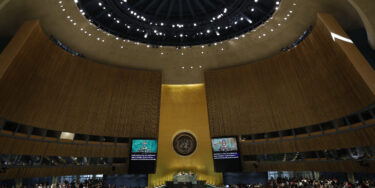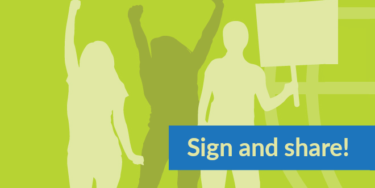September 28: 14 Resources for Activism for Safe and Legal Abortion
28.09.17
Everybody in the world is entitled to bodily autonomy and freedom, without discrimination. Yet we continue to see the human right to safe and legal abortion imperiled by anti-rights actors from country to country, and repeatedly attacked at the international level.
As the year began, Donald Trump’s reinstatement of the “Global Gag Rule” cut off all US funding to overseas NGOs in any way associated with abortion provision, putting the health and lives of millions at risk. In May, a 19-year-old in El Salvador, who had become pregnant after she was raped, was sentenced to 30 years in jail after suffering a stillbirth. Even in some places were abortion is legal, such as Italy, accessing abortion can be extremely difficult due to the high number of providers who refuse to conduct the procedure on the grounds of “conscientious objection”.
Furthermore, across the diversity of legal contexts, a person’s ability to access safe abortion depends on a number intersecting factors such as residency or citizenship status, age, being part of an ethnic minority or an indigenous community, and socio-economic status. The world over, those living in poverty experience the most difficulty accessing safe abortion.
Today, September 28th, marks the Global Day of Action for Access to Safe and Legal Abortion. Today we come together to declare that our bodies, health, and choices are our own, and cannot be held hostage by the oppressive forces that seek to lay claim to us. Today is also a day for us to celebrate our struggles, and the struggles of activists worldwide. Because despite the many threats we face, our resistance is not letting up.
This September 28, we are highlighting a selection of resources for activists working to further safe and legal abortion and on rights related to gender and sexuality worldwide. Please share these with your networks, and let us know of your key resources! Tweet in solidarity using the hashtags #IPersistWeResist and #RightsAtRisk
This set of comic-strips by WGNRR and Ipas on activism for safe and legal abortion includes case-studies of resistance from South Africa, India, and Poland.
This new open-access database from WHO and the Population Division of the United Nations Department of Economic and Social Affairs provides information on laws, policies, and health standards on abortion in countries worldwide, and is searchable by an intricate set of criteria.
This six-pager from the Sexual Rights Initiative lays out the fundamental right to abortion from an international law perspective; how criminalization leads to the denial of women’s fundamental rights to life, to health, to bodily autonomy, to freedom from torture, and to freedom from discrimination.
This toolkit from the Center for Reproductive Rights breaks down the emerging trend to extend a right to life before birth, and in particular from conception. It provides way to respond to this trend, which poses a significant threat to women’s human rights.
This paper from AWID discusses the health issues and rights violations faced by women in Mato Grosso do Sul in Brazil, where abortion is criminalized. It discusses the history and pitfalls of criminalizing abortion, and uses the Mato Grosso do Sul case study to investigate the numerous rights violations in the region.
The first Trends Report from OURs is a comprehensive resource outlining the key actors, discourses, and strategies in the global anti-rights lobby. With abortion a key battleground for these actors, it contains a wealth of information on the strategies of ultraconservative actors to roll back women’s right to choose.
This resource from Ipas includes a review of abortion providers’ ethical obligations to maintain confidentiality, a review of human rights protections related to privacy in health care, and an analysis of how confidentiality is treated in different national laws. It also shows that requiring providers to report women suspected of obtaining unlawful abortions violates protections of privacy and confidentiality under international human rights law.
In this factsheet for advocates and policymakers, Ipas explain how The 2030 Agenda for Sustainable Development can be a powerful tool for advancing adolescent girls’ and young women’s sexual and reproductive rights—especially their right to safe, legal abortion. It includes explanations of how specific goals and targets within the development agenda apply to women’s right to safe abortion, and how to hold governments accountable to these goals.
This resource from Women Help Women goes into depth about how abortion stigma operates, with a specific focus on countries where access to safe abortion is restricted and on the independent use of abortion medicines. It provides models of advocacy that can address stigma, and features reflection on some of the paradoxes of this area of work.
This resource in Spanish from Católicas por el Derecho a Decidir discussed social, ethical, and religious aspects of the debates around abortion. It discusses abortion reform in Mexico, breaks down arguments that equate abortion with homicide, and discusses abortion from the perspective of freedom of conscience and the right to decide.
This annual publication from the Center for Reproductive Rights summarizes the jurisprudence from United Nations treaty monitoring bodies on reproductive rights, particularly the standards on maternal health care, abortion, and contraception.
This guide from IPPF is designed to help organizations review communications materials that include messages about abortion. It includes “golden rules of abortion messaging” and checklists to review and improve abortion messaging.
This two-page factsheet from Planned Parenthood demonstrates the many health benefits — physical, emotional, and social — that have resulted in the US since have 1973, when the U.S. Supreme Court legalized abortion in its decision, Roe v. Wade
This paper by ARROW discusses the legal barriers, social stigma, and lack of information faced by young women in the Asia-Pacific region. It provides case studies from the Philipines and Pakistan, and monitors developments internationally and in countries in the region.



